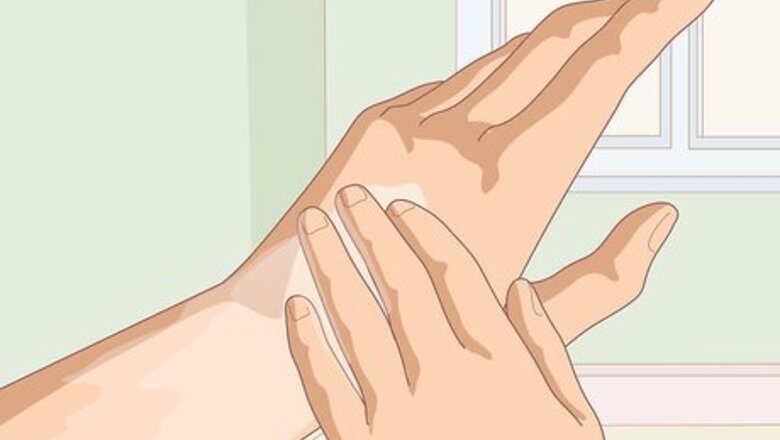
views
Wearing and Storing the Pearls
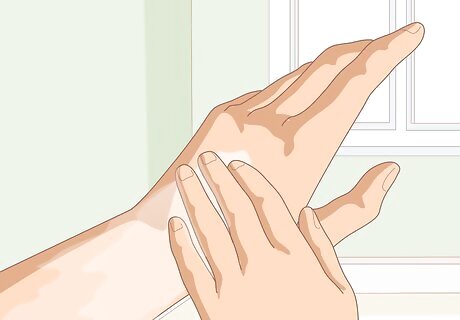
Apply deodorant, perfume, makeup, or lotion before you put on the pearls. Pearls are sensitive to chemicals or harsh ingredients that are found in cosmetics. To prevent your pearls from peeling, put on your hairspray, makeup, lotions, and any other cosmetics before you wear the pearls.Tip: Never wear pearls if you'll be working out and sweating a lot. The sweat will damage the luster and cause the pearl to peel. You should also avoid swimming while wearing the pearls, since chlorine is too harsh for them. If you forgot to apply hairspray or perfume, take the pearls off. Then, use the product and put the pearls back on.
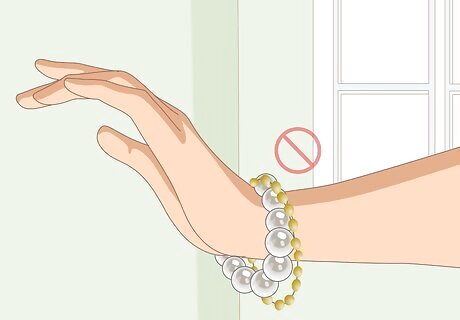
Avoid wearing pearl necklaces or bracelets with other jewelry. It might be tempting to wear a pearl bracelet with your favorite silver bangle, but the other piece of jewelry can scratch the pearls, causing them to flake. To minimize peeling, don't wear pearl jewelry with other strands of jewelry. You can wear pearl earrings or a pearl ring without worrying about it rubbing against your other jewelry. If you're wearing a pearl bracelet, you'll still need to be careful so you don't bump or scrape the pearls while they're on your wrist.
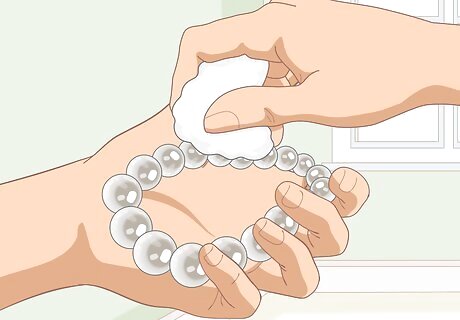
Wipe down the pearls with a soft cloth when you take them off. When you've finished wearing the pearls for the day or evening, remove them before taking off your clothes or makeup. Then, take a soft dry cloth and gently wipe down each pearl to remove any dust or oils before storing them.
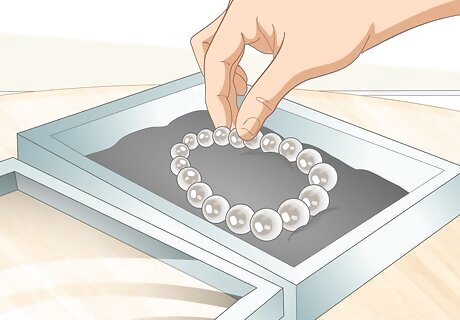
Arrange your pearls so they're flat in a soft storage container. Protect the pearls from bumping into each other when you're not wearing them by laying them in a soft container. If you're using a jewelry box, lay the pearls so they're in a single layer. To store them in a jewelry pouch, position the pearls so they're not rubbing against each other.Tip: If you're storing a necklace or bracelet, close the clasp so the ends of the jewelry don't scratch the pearls. To store pearl earrings, lay them so the clasp isn't overlapping the pearl. Don't store the pearls in a sealable plastic bag or airtight container, which can dry out and damage the pearls. If you're storing several pieces of pearl jewelry together, ensure that they're not touching each other, which could cause the pearls to flake.
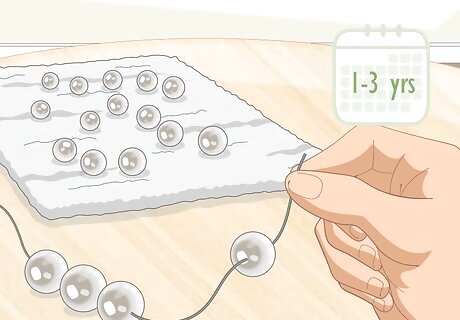
Restring a pearl necklace or bracelet every 1 to 3 years. The thread that's knotted between each pearl will loosen over time, especially if you wear the necklace or bracelet frequently. To prevent the pearls from sliding into each other, which can cause flaking, take them to a jeweler to be restrung. Take the jewelry in as soon as you notice the thread fraying, loosening, or becoming yellow.
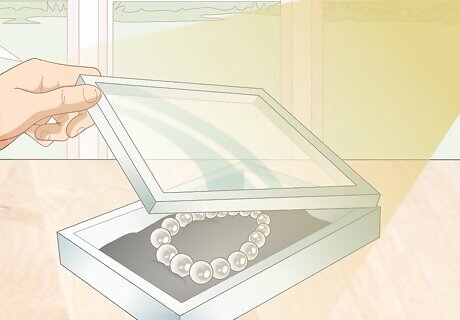
Protect the pearls from direct sunlight and extreme heat. Whether you're wearing or storing the pearls, don't expose them to very dry, hot temperatures or they may peel. Pearls will also begin to flake if they dry out, so try to store them in a humid space when you're not wearing them. If you're preparing the pearls for long-term storage in a safe, place a glass of water in the safe with the pearls. This creates a humid environment so the pearls don't dry out.
Cleaning Your Pearls
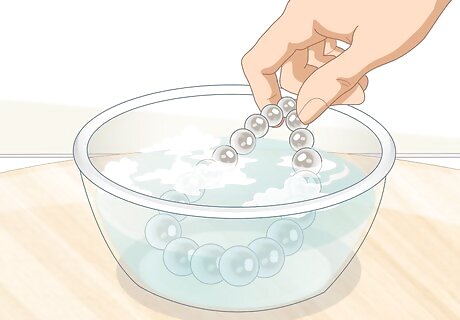
Submerge the pearls in soapy water to remove dirt. If your pearls are looking dusty or losing their luster, fill a metal or plastic bowl or container with distilled water and a squirt of mild, all-natural dish soap. You could also fill a clean sink with distilled water. Swish the water to make it soapy and lay a soft cloth in the bottom. Then, place the pearls on the cloth so they're covered with the soapy water. There's no need to rub or scrub the pearls, which could make them peel. Submerging them briefly is enough to remove most surface dirt or grime.
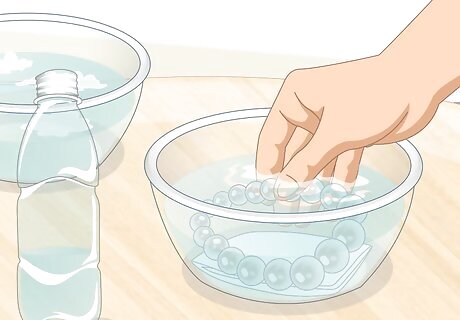
Rinse the pearls in distilled water to remove traces of soap. Fill a separate bowl or dish with distilled water and place a cloth in the bottom. Lower the soapy pearls into the distilled water so it rinses away soapy residue. Use a clean cloth instead of the one you used to wash the pearls since that cloth has soap in it.
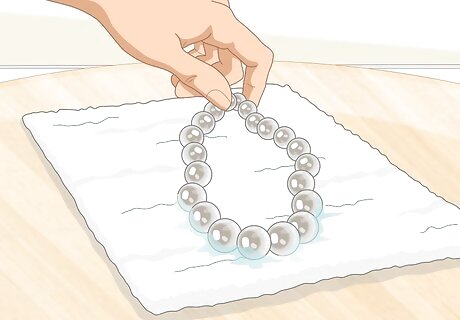
Lay the pearls flat on a clean towel to dry. Place a dry towel on the counter next to the pearls. Scoop up the pearls with both of your hands and lay them on the towel. Fold the other end of the towel over the pearls and gently pat them dry. Then, leave the pearls until the towel feels completely dry. Don't rub the towel vigorously against the pearls or you could make them peel. The pearls dry quickly, but the thread between them takes longer to dry. Avoid pulling on the strand of pearls until the thread is dry or you could damage it.
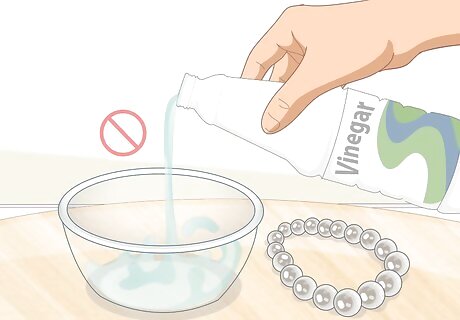
Avoid using vinegar or ammonia to clean your pearls. Pearls only need a gentle soapy cleanser since harsh cleansers or home treatments can cause the pearls to peel. Don't use vinegar or ammonia-based cleansers, since these are too acidic and can damage the surface of the pearls. If you want to use a liquid jewelry cleaner, it's important to find one that's labeled as being safe for pearls. If you're wearing the pearls and something acidic, such as salad dressing or lemonade, gets on them, rinse the pearls immediately and pat them dry. It may be better to give them to a professional for cleaning.
They can be damaged easily. The stringing can also break.
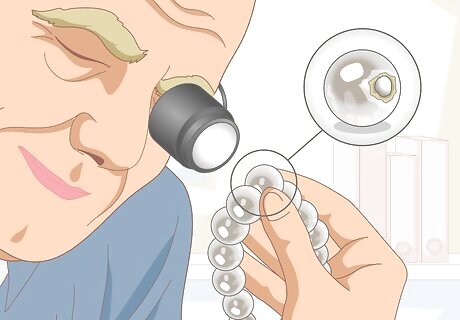
Take already-flaking pearls to a jeweler for a professional evaluation. If your pearls are already flaking near the drilling holes, don't attempt to peel or polish them. It's better to let a professional jeweler look at them and tell you if anything can be done.Tip: It's also a good idea to take the pearls to the jeweler if you suspect that the pearls aren't real. The jeweler can tell you if they're peeling because they're imitations or because they're real pearls that have been mishandled.


















Comments
0 comment